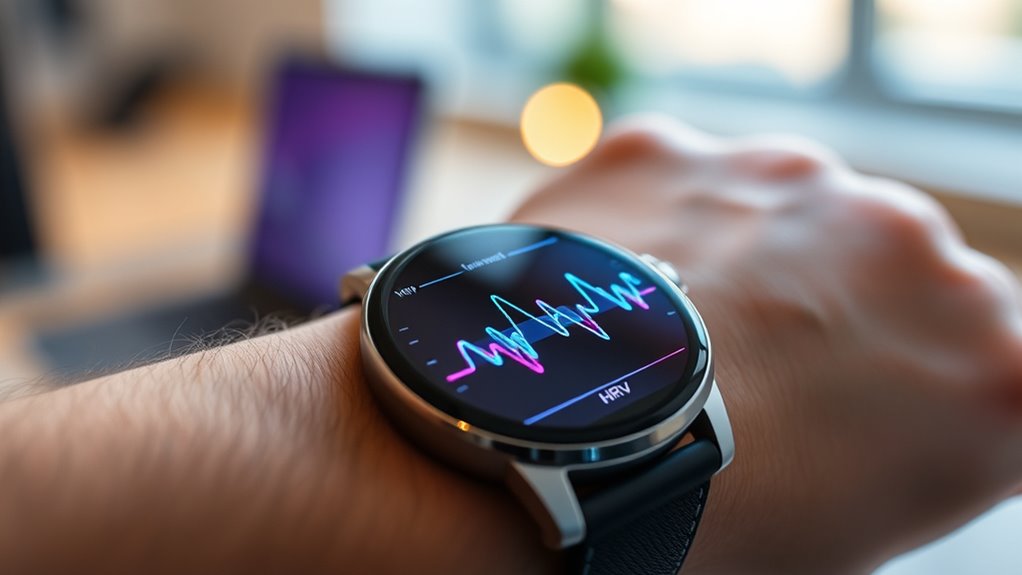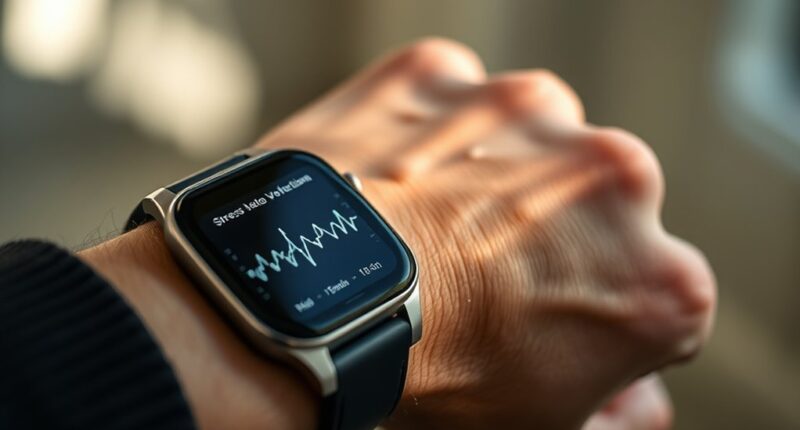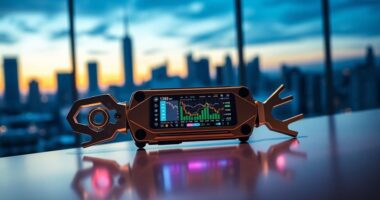Your smartwatch detects your stress early by analyzing heart rate variability (HRV), a key physiological sign controlled by your autonomic nervous system. When you’re stressed, HRV decreases as your body shifts into a heightened alert state, even before you notice any feelings. The device monitors subtle changes in heartbeat patterns and other cues to recognize stress responses in real-time. Keep exploring to discover how these signals work together to keep you informed before stress hits you emotionally.
Key Takeaways
- HRV reflects autonomic nervous system balance; lower HRV indicates stress before you consciously realize it.
- Wearables continuously monitor physiological signals, detecting subtle stress-related changes early.
- Decreased HRV signals sympathetic activation, often occurring before physical or emotional awareness of stress.
- Machine learning algorithms analyze patterns over time to identify early stress indicators from HRV data.
- Personalized baseline data allows smartwatches to flag deviations and alert you to stress before symptoms emerge.

Have you ever wondered how your smartwatch can tell when you’re stressed? It’s pretty remarkable how these devices, small enough to wear on your wrist, can monitor your body’s subtle signals and interpret them in real-time. The secret lies in the way smartwatches continuously track various physiological metrics, especially heart rate and heart rate variability (HRV). By monitoring your heart rate, the watch observes how fast your heart is beating at any given moment. But more importantly, it measures HRV — the variation in time between each heartbeat. HRV is a powerful indicator of your autonomic nervous system‘s activity and balance. When you’re relaxed, your HRV tends to be higher, reflecting a calm, balanced state. When stress kicks in, HRV decreases as your sympathetic nervous system takes over, signaling heightened alertness and tension.
Smartwatches detect stress by monitoring heart rate variability, reflecting your body’s balance between relaxation and tension.
Your smartwatch also measures skin conductance, known as galvanic skin response (GSR). This detects changes in sweat gland activity, which often increase when you’re stressed. As your body responds to stress, sweat production ramps up, and the device picks up these electrical changes through sensors on your skin. Additionally, your smartwatch monitors your breathing rate. Stress typically causes you to breathe faster or more shallowly, so by tracking your respiration pattern, the device gains another piece of the puzzle. It may also record blood oxygen levels and other biometric data, helping to identify deviations from your normal state. To guarantee accuracy, the watch first establishes a baseline by observing your metrics during relaxed periods, giving it a personalized reference point for comparison. Furthermore, continuous data collection enables the device to spot patterns over time, enhancing its ability to detect subtle shifts in your stress levels. Incorporating machine learning techniques allows the smartwatch to better interpret complex physiological signals and improve its predictive accuracy.
This continuous monitoring offers a significant advantage: it provides real-time alerts, allowing you to recognize stress early and take action. You can see how your stress levels fluctuate throughout the day, identify triggers, and develop healthier coping strategies. Because these sensors are integrated into a wearable device, they eliminate the need for bulky medical equipment, making stress tracking accessible and convenient. While some limitations exist, such as sensor quality and movement artifacts, the overall science behind HRV and physiological monitoring makes your smartwatch a surprisingly insightful tool for understanding your stress before you even realize you’re feeling it.
Frequently Asked Questions
Can HRV Monitoring Predict Future Stress Episodes?
You might wonder if HRV monitoring can predict future stress episodes. It can, to some extent, as changes in HRV patterns over time help identify when you’re likely to experience stress again. Wearable devices track these patterns continuously, giving you early warnings. However, predicting exact moments remains challenging due to individual differences and methodological limitations. Still, consistent HRV monitoring can improve your awareness and help you manage stress proactively.
How Accurate Are Smartwatches in Detecting Stress?
Imagine your smartwatch acting like a vigilant friend, catching signs of stress before you even feel it. Its accuracy hovers around 85%, thanks to sensors measuring heart rate variability and other signals. While not perfect, it’s pretty good at flagging stress, especially when combined with advanced algorithms. But keep in mind, device type and data quality can influence how precisely it detects your stress levels.
Does HRV Vary Significantly Between Individuals?
You might wonder if HRV varies a lot between individuals. It does, due to factors like age, sex, fitness, health, and environment. Some people naturally have higher HRV, indicating better autonomic balance, while others have lower HRV. These differences are normal and influenced by genetics, lifestyle, and even measurement methods. So, your HRV isn’t static—it reflects your unique physiology and circumstances.
Can Lifestyle Changes Improve HRV Scores?
Sure, changing your lifestyle can actually boost your HRV scores—imagine that! By eating leafy greens, staying hydrated, exercising regularly, and managing stress, you actively support your heart’s health. Avoiding overtraining, getting quality sleep, and maintaining routines help your autonomic nervous system chill out. So, yes, your daily choices matter; they’re like a personal upgrade for your heart’s resilience, making stress less of a surprise guest.
Are There Privacy Concerns With Stress Data Collection?
You should know that collecting stress data raises significant privacy concerns. When your smartwatch tracks sensitive health information like HRV, it often stores this data on cloud servers, which can be vulnerable to hacking or misuse. Default privacy settings may inadvertently share your info publicly, risking exposure. Without clear transparency and proper safeguards, your personal stress levels could be accessed or used without your consent, compromising your privacy and security.
Conclusion
Now that you know how your smartwatch detects stress through HRV, isn’t it amazing how technology can read your body’s signals before you even realize? By paying attention to these insights, you can better manage your well-being and catch stress early. So, next time your watch alerts you, will you take a moment to breathe and reset? After all, understanding your body’s subtle cues might just be the key to a calmer, healthier you.









